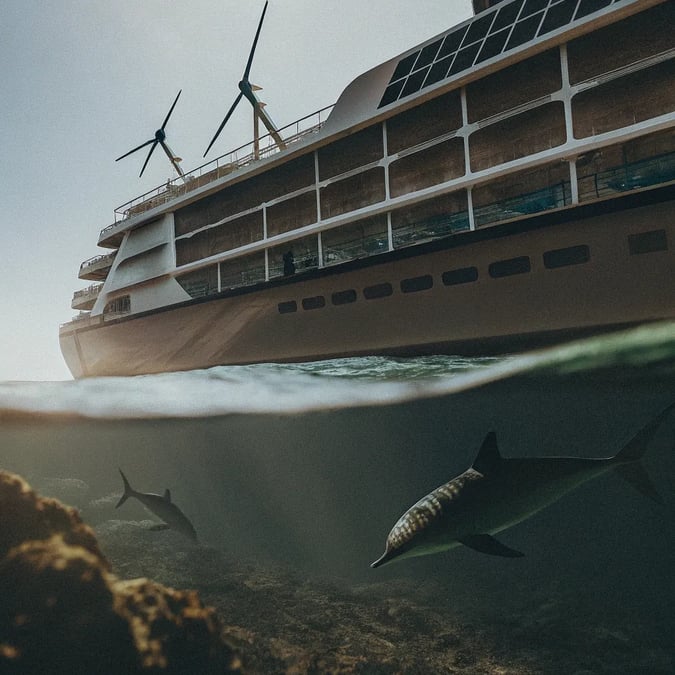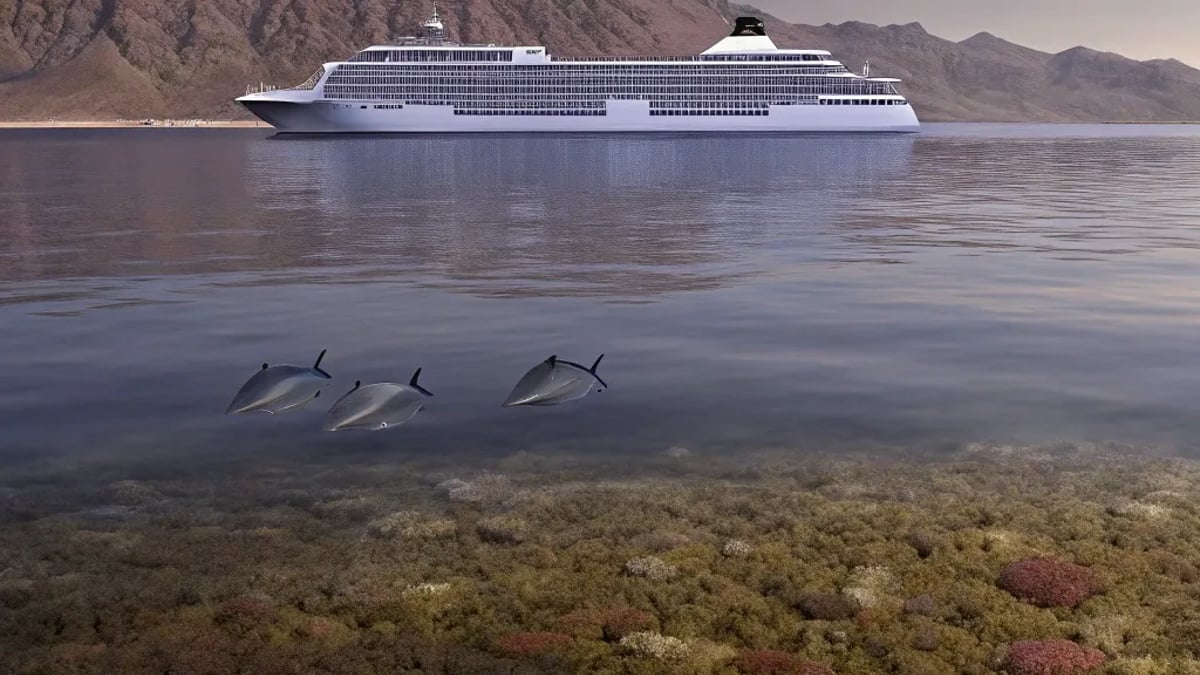
The cruise industry has long been criticized for its environmental impact, with traditional vessels releasing massive amounts of pollutants into our oceans and atmosphere. Recently, however, a wave of innovation has brought hybrid cruise ships to the forefront, offering promising solutions to reduce maritime pollution while still delivering unforgettable vacation experiences.
The Environmental Cost of Traditional Cruising
Anyone who's witnessed a cruise ship gliding majestically across the horizon might be surprised to learn what's happening beneath the surface. Traditional cruise ships have been environmental nightmares, with some shocking statistics to back this up.
According to discussions on Reddit and environmental forums, a single cruise ship can emit as much pollution as a million cars in just one day. This staggering figure highlights why the industry has faced mounting pressure to clean up its act.
The pollution problem extends beyond just emissions. Cruise ships generate several types of environmental impacts:

- Air pollution: Heavy fuel oil used by most ships contains high levels of sulfur, releasing sulfur oxides (SOx), nitrogen oxides (NOx), and particulate matter
- Water pollution: Wastewater discharge, including sewage and "gray water" from sinks and showers
- Noise pollution: Underwater noise that disrupts marine life communication and behavior
- Solid waste: Trash and non-biodegradable materials that can end up in oceans
A 2012 study highlighted in a recent BBC Future article found that mid-range frequencies of noise from ships can travel extraordinary distances underwater, affecting marine mammals that rely on sound for navigation and communication.
The Rise of Hybrid Technology in Cruising
What Makes a Cruise Ship "Hybrid"?
Hybrid cruise ships combine traditional propulsion systems with alternative power sources to reduce environmental impact. Unlike conventional vessels that rely solely on heavy fuel oil, hybrid ships incorporate:
- Battery systems for electric propulsion
- Liquefied Natural Gas (LNG) capabilities
- Solar panels (on some vessels)
- Shore power connections (cold ironing)
- Energy recovery systems

Hurtigruten, a Norwegian cruise line, made headlines in 2019 when they launched the MS Roald Amundsen, widely considered the world's first hybrid-powered expedition cruise ship. According to ABC News, this groundbreaking vessel was specifically designed to help reduce emissions from marine transportation.
How These Systems Work Together
The magic of hybrid cruise ships happens in their integrated power management. During peak power demands (like departure from port), they might use both traditional engines and battery power. When cruising at steady speeds, they can optimize for efficiency, sometimes running solely on cleaner fuels or battery power for limited periods.
Shore power connections allow ships to "plug in" while docked rather than running engines for electricity. This eliminates emissions while in port—often near populated areas where air quality concerns are highest.
Real-World Impact: Success Stories
The impact of these technological advancements isn't just theoretical. Early adopters are already demonstrating measurable benefits.
Hurtigruten's MS Roald Amundsen reduces fuel consumption and CO2 emissions by approximately 20% compared to traditional ships of similar size. This reduction comes from its hybrid power system that combines marine gasoil with battery packs, allowing the ship to operate on electric power alone for short periods.

NBC News reported in 2019 that the vessel represents a significant milestone in the war against ocean pollution. While not fully electric, its hybrid system marks a crucial step toward cleaner cruising.
Other companies have followed suit. Finnish shipbuilder Meyer Turku delivered Costa Smeralda to Costa Cruises in 2019, one of the first cruise ships powered entirely by liquefied natural gas (LNG), which produces significantly fewer emissions than traditional marine fuels.
How Do Hybrid Ships Reduce Different Types of Pollution?
Air Pollution Reduction
The most immediate benefit of hybrid technology is reduced air pollution. According to research published in Science Direct, these systems can substantially minimize greenhouse gas emissions while optimizing energy efficiency.
Specifically, hybrid ships achieve this through:
- Lower sulfur emissions by using cleaner fuels like LNG
- Reduced carbon dioxide output through more efficient engines and battery assistance
- Decreased particulate matter by avoiding heavy fuel oil
- Minimal nitrogen oxide emissions with advanced catalytic converters
When ships can run on battery power while in port, they eliminate emissions entirely during these periods—a significant improvement for port cities that have historically suffered from poor air quality due to docked vessels.
Water Pollution Improvements
Beyond air quality, hybrid ships often incorporate advanced wastewater treatment systems. These technologies allow vessels to treat sewage and gray water to higher standards before release.
Some newer hybrid vessels feature:
- Advanced membrane bioreactors for wastewater treatment
- Ballast water management systems to prevent invasive species transfer
- Zero discharge policies in sensitive ecological areas
Noise Reduction Benefits
The quieter operation of electric propulsion has a surprising beneficiary: marine life. Traditional cruise ships create significant underwater noise pollution that disrupts marine mammals' communication and navigation systems.
When operating on battery power, hybrid ships produce substantially less underwater noise. This reduction helps minimize stress on marine ecosystems, particularly for species like whales and dolphins that rely heavily on sound.
What Are the Challenges and Limitations?
Despite their promise, hybrid cruise ships face significant hurdles. Last Tuesday, I was reading a report that highlighted some major challenges the industry still needs to overcome:
The battery technology, while improving, still can't support extended periods of all-electric cruising. Most hybrid ships can only operate on battery power for very limited durations—typically just enough for port operations or short scenic cruising in protected areas.
Infrastructure remains underdeveloped in many ports. Shore power capabilities aren't universally available, meaning ships can't always "plug in" even when they have the technology to do so.
Cost is perhaps the biggest barrier. Building hybrid cruise ships requires significantly higher initial investment—sometimes 20-30% more than conventional vessels. For cruise lines operating on tight margins, especially after the industry's pandemic struggles, this represents a major hurdle.
And let's be honest—these improvements, while significant, don't completely solve the pollution problem. A hybrid cruise ship still produces substantial emissions compared to not traveling at all. As a BBC Future article from June 28, 2024 points out, even "green" cruise ships raise questions about their climate impact.
What's on the Horizon? Future Developments
The current generation of hybrid ships represents just the beginning of a longer journey toward truly sustainable cruising. Several promising developments are on the horizon:
Hydrogen Fuel Cell Technology
Several major cruise lines are investing in hydrogen fuel cell research. These systems combine hydrogen and oxygen to produce electricity, with water as the only byproduct. Royal Caribbean has announced plans to incorporate fuel cell technology in upcoming vessels.
Fully Electric Short-Route Cruising
For shorter itineraries, fully electric cruise ships may become viable within the next decade. These would operate similar to electric ferries already in service in places like Norway and Denmark, though with the amenities and scale of traditional cruise vessels.
Advanced Materials and Design
Future cruise ships will likely incorporate innovative hull designs and materials that reduce drag and improve efficiency. Some concepts include air lubrication systems that create a carpet of bubbles beneath the hull to reduce friction.
Artificial Intelligence for Optimization
AI systems are being developed to continuously optimize ship operations, adjusting power usage, speed, and routing to minimize environmental impact while maintaining schedules.
How Can Passengers Support Greener Cruising?
As a traveler who enjoys cruising but worries about its environmental impact, I've found several ways to support the industry's greener direction:
- Choose hybrid or LNG-powered ships when booking your next cruise
- Research cruise lines' environmental policies before booking
- Participate in onboard conservation programs during your cruise
- Provide feedback to cruise lines expressing your interest in environmental initiatives
- Consider carbon offset programs to mitigate the impact of your travel
Many cruise lines now publish sustainability reports that detail their environmental initiatives and progress. Norwegian Cruise Line Holdings, for example, has committed to a "Sail & Sustain" program with specific targets for emission reductions and waste management.
Is Hybrid Technology Enough to Make Cruising Sustainable?
This is the million-dollar question facing the industry. While hybrid technology represents a significant improvement, it's important to maintain perspective about what "green cruising" really means.
Even the most advanced hybrid cruise ships today still have substantial environmental footprints. The BBC Future article from June 2024 raises important questions about whether these improvements are sufficient given the scale of the climate crisis.
That said, the technology is evolving rapidly. What seems like modest improvement today may pave the way for truly revolutionary changes in the coming decades. The first hybrid cars weren't perfect either, but they helped drive the development of today's increasingly viable electric vehicle market.
For the cruise industry, hybrid technology represents an important first step—not the final destination.
Frequently Asked Questions: Are Hybrid Cruise Ships Really Better for the Environment?
The short answer is yes, but with important qualifications. Hybrid cruise ships do produce fewer emissions and cause less pollution than their conventional counterparts. A study referenced in Science Direct indicates these systems can optimize energy efficiency in marine vessels while minimizing greenhouse gas emissions.
However, "better" doesn't mean "good." Even the most advanced hybrid cruise ships still create significant environmental impacts. They're an improvement over traditional vessels but not a complete solution to maritime pollution.
Think of it this way: a hybrid cruise ship might be 20-30% cleaner than a conventional one, which is meaningful progress. But if you're primarily concerned about environmental impact, alternative vacation options like train travel or local tourism will generally have smaller carbon footprints.
That said, for travelers who love the cruise experience, choosing a hybrid or LNG-powered vessel represents a responsible choice that helps push the industry toward greener practices.
Conclusion
The emergence of hybrid cruise ships marks a significant turning point in the industry's environmental journey. While these vessels don't solve all the problems associated with cruise pollution, they represent meaningful progress toward more sustainable maritime tourism.
As technology advances and more cruise lines invest in hybrid systems, we can expect to see continued improvements in efficiency and reductions in environmental impact. For passengers, the growing availability of these greener options means the possibility of enjoying the unique experiences cruising offers with a somewhat clearer conscience.
The true test will be whether these innovations serve as stepping stones to truly sustainable cruising or merely as incremental improvements that fall short of what our oceans need. Either way, hybrid cruise ships are currently the best available option for environmentally conscious travelers who still want to experience the unique joy of a vacation at sea.
Tags

About Isabella Montgomery the Author
With over 15 years of experience charting the world's most remote waters, Isabella Montgomery is a seasoned explorer and a leading voice in expedition-cruises, blending her nautical expertise with a passion for discovering untouched landscapes and diverse cultures.
Recommended Articles
The 2026 Wellness Checklist (No Hype, Just Health)
Discover practical tips in the 2026 Wellness Checklist for balanced physical and mental health. No hype, just health!
2026 Nissan Terra: Rugged Power Meets Modern Comfort
Discover the 2026 Nissan Terra, blending rugged strength with modern comfort. Perfect for families and adventure seekers alike.
2026 Subaru Forester Premium: Comfortable and Ready for Adventure
Discover the 2026 Subaru Forester Premium, an SUV combining comfort and adventure readiness for families and explorers alike.
A Guide to Cutting the Cord and Switching to Streaming
Discover how to cut the cord and transition from cable to streaming with our comprehensive guide, including tips on platforms and budgeting.
9 Rare Creatures Caught on Trail Cameras That Will Shock You
Discover nine astonishing rare creatures caught on trail cameras, showcasing the hidden wonders of wildlife and the surprising moments they reveal.




